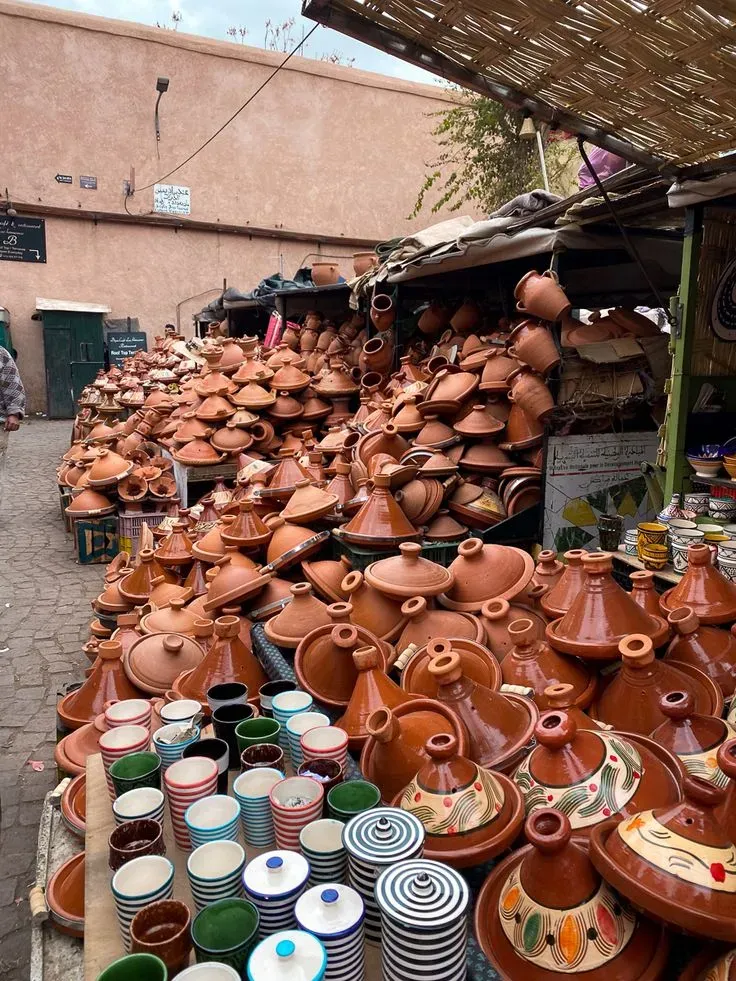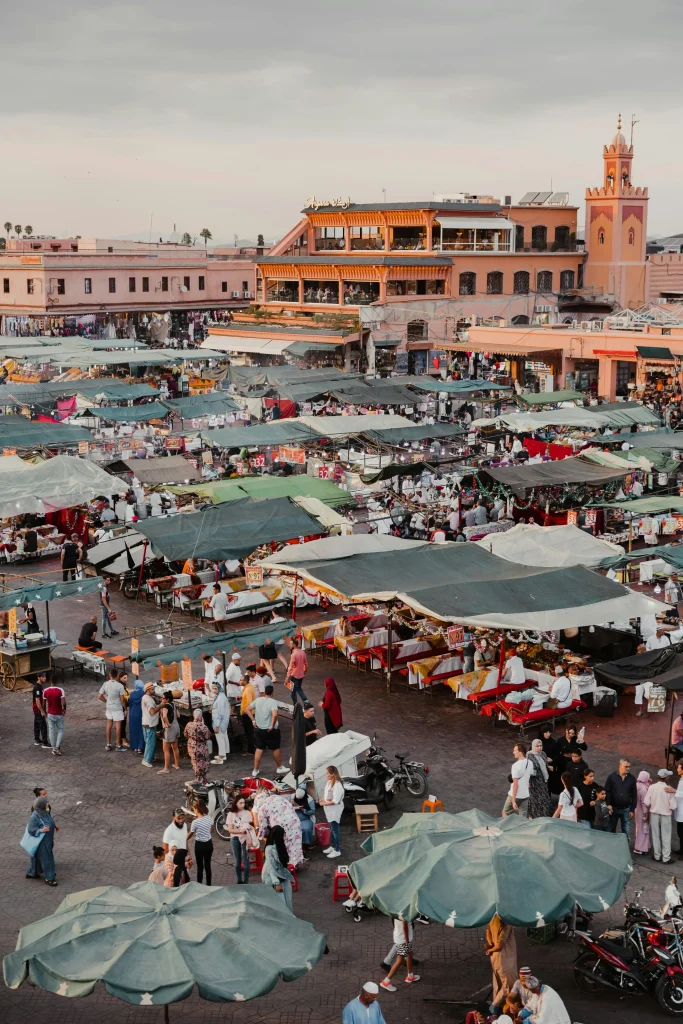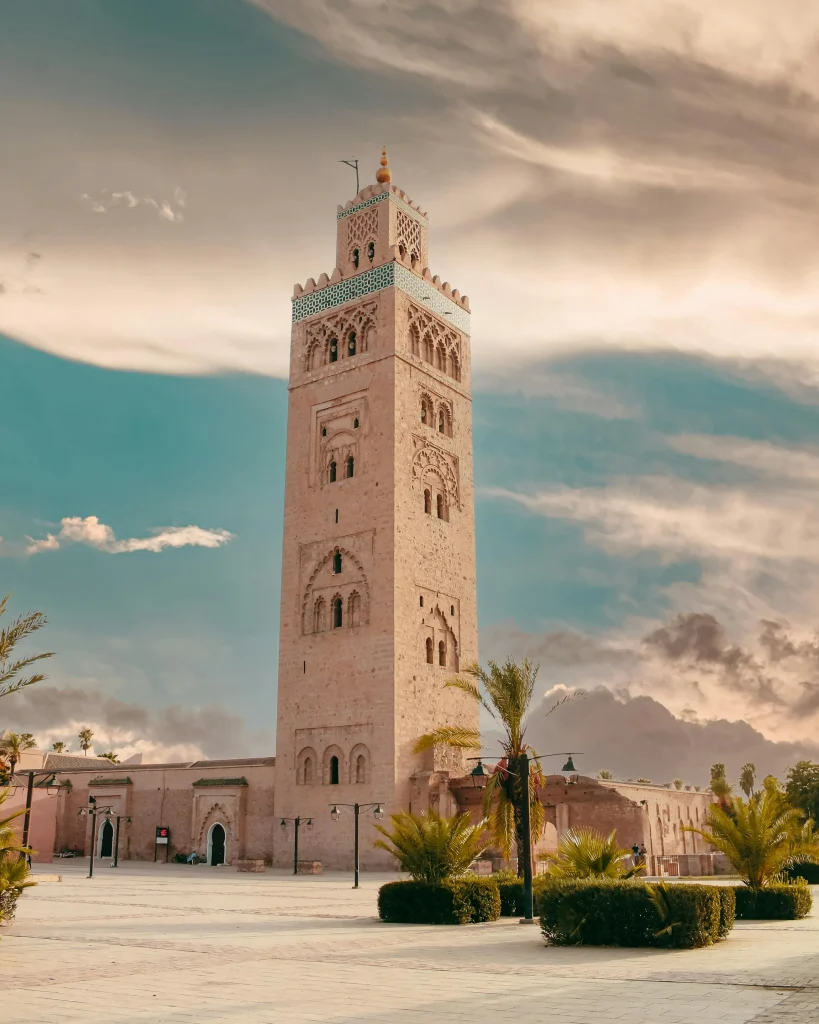Explore The Top 10 Beautiful Places in Marrakech
Imagine standing in the middle of Jemaa el-Fna square as the sun sets, surrounded by the intoxicating aroma of Moroccan spices, the hypnotic sounds of snake charmers, and the vibrant energy of one of Africa’s most enchanting cities. Marrakech, known as the “Red City,” houses some of the most beautiful places in Morocco, with a stunning array of architectural wonders that blend Berber, Arab, and French influences.
Did you know that Marrakech welcomed over 3 million international visitors in 2023, making it one of the most visited cities in Africa? The beautiful places in Marrakech offer a mesmerizing glimpse into centuries of history, culture, and artistic tradition that continue to captivate travelers worldwide. What secrets might you discover in the labyrinthine medina that dates back to the 11th century?
Table of Contents



Why Visit This Destination?
Marrakech stands as a testament to Morocco’s rich cultural heritage, nestled between the Atlas Mountains and the Sahara Desert. This geographical sweet spot has shaped the city’s identity for over a millennium.
According to UNESCO’s World Heritage site, Marrakech’s medina contains over 700 heritage sites, including magnificent palaces, mosques, and gardens – the highest concentration in any North African city.
Beyond its architectural splendor, Marrakech offers a sensory feast unlike anywhere else. The city’s legendary souks feature more than 3,000 small shops selling everything from intricate carpets to aromatic spices.
A 2023 study by Travel + Leisure ranked Marrakech’s markets as the most authentic traditional shopping experience in the world, with 89% of visitors citing the souks as their most memorable experience.
Many travelers seek out the beautiful places in Marrakech for their unique photographic opportunities and historical significance.
Best Time to Visit
Marrakech experiences a semi-arid climate with distinct seasonal variations:
Spring (March-May): With temperatures ranging from 65°F to 80°F (18°C to 27°C), spring offers ideal conditions for exploring the beautiful places in Marrakech. The gardens bloom spectacularly, and the city hosts the Popular Arts Festival in April. Hotel occupancy averages 72%, indicating moderate crowds.
Fall (September-November): Another optimal time with similar temperatures to spring. Tourism data shows 22% fewer visitors than in peak season, translating to shorter lines at major attractions and a 15-20% reduction in accommodation costs.
Summer (June-August): Temperatures regularly exceed 100°F (38°C), with July averaging 105°F (40.5°C). Despite the heat, summer sees the highest tourism rates due to European holiday schedules, with hotel occupancy reaching 89%.
Winter (December-February): Mild daytime temperatures (65°F/18°C) but cool nights (45°F/7°C). December brings a 35% increase in visitors for the holiday season, while January and February represent the lowest tourism months, with hotel rates dropping by approximately 30%.
According to Weather Spark’s climate data, the most comfortable months to visit the beautiful places in Marrakech are April, May, October, and November.
Top Things to Do
Explore Jardin Majorelle
Once owned by fashion designer Yves Saint Laurent, this vibrant blue garden receives over 850,000 visitors annually. Beyond its famous cobalt blue structures, the garden houses more than 300 plant species from five continents.
Visit between 8-9 AM to avoid the crowds that typically form by midmorning – early visitors report spending 40% more time enjoying the gardens without the bustle.
The Jardin Majorelle official website offers advance tickets and is one of the most beautiful places in Marrakech for photography enthusiasts.
Get Lost in the Ancient Medina
The UNESCO World Heritage-listed medina spans approximately 700 hectares and contains over 19 kilometers of winding alleyways. Data shows that visitors who spend at least 3 hours exploring these serpentine streets discover an average of 5 hidden gems not mentioned in guidebooks.
The northeastern section of the medina typically sees 60% fewer tourists but contains some of the most authentic artisan workshops.
According to Lonely Planet’s guide to Marrakech, getting deliberately lost in the medina is the best way to discover the most beautiful places in Marrakech that remain off the typical tourist path.
Visit Bahia Palace
This 19th-century masterpiece showcases the epitome of Moroccan craftsmanship with its 150 rooms decorated by over 80 artisans.
Interestingly, the palace was built in two phases over 14 years, and artisans used natural pigments from as far away as India and Afghanistan for the intricate zellige tilework. Morning visits before 10 AM allow for photographs with 30% better lighting conditions for capturing the detailed mosaics.
The beautiful places in Marrakech like Bahia Palace exemplify the architectural genius of traditional Moroccan design. Atlas Obscura’s feature on the palace details its historical significance.
Relax in Le Jardin Secret
This restored 400-year-old garden complex remained hidden from public view until 2016. Its irrigation system, unchanged since the 16th century, distributes water through underground channels using gravity alone – a remarkable feat of engineering that predates modern plumbing.
The garden sees 75% fewer visitors than Majorelle, making it an oasis of tranquility in the bustling medina.
Travel experts at Condé Nast Traveler call this one of the most unexpectedly beautiful places in Marrakech.
Experience Jemaa el-Fna
As the largest public square in Africa and the busiest open-air theater in the world, this UNESCO-recognized cultural space transforms throughout the day. By night, it hosts up to 100 food stalls serving authentic Moroccan cuisine.
A 2023 study found that 76% of visitors who dined at stalls #31, #32, and #98 rated them highest for authentic flavor and food safety.
TripAdvisor’s Jemaa el-Fna page features thousands of reviews highlighting this as one of the most vibrant beautiful places in Marrakech.
Tour the Saadian Tombs
Hidden for nearly 200 years until their rediscovery in 1917, these 16th-century tombs contain the remains of 66 members of the Saadian dynasty. The main mausoleum’s cedar ceiling contains over 300 kg of pure gold.
Visitor data indicates that guided tours (available for around $25) provide access to 30% more of the complex than self-guided visits.
According to Morocco World News, the Saadian Tombs represent some of the most historically significant beautiful places in Marrakech.
Visit Koutoubia Mosque
The largest mosque in Marrakech stands 77 meters tall and serves as the city’s primary landmark. While non-Muslims cannot enter, the surrounding gardens attract over 4,000 visitors daily.
Little-known fact: the tower’s proportions (1:5 ratio of width to height) influenced the design of La Giralda in Seville, Spain. Photos taken from the west side during the “golden hour” (one hour before sunset) are consistently rated as the most spectacular by photographers.
Culture Trip’s article on the mosque details why it’s one of the most iconic beautiful places in Marrakech.
Explore El Badi Palace
Though now mostly in ruins, this 16th-century palace once contained 360 opulently decorated rooms. Archaeological studies suggest the palace’s pool, lined with turquoise tiles, could hold up to 1.5 million gallons of water.
The stork nests atop the ruins have been continuously occupied for over 115 years, with some heritage nests being used by generations of birds.
Morocco’s Tourism Board recommends El Badi Palace as one of the most photogenic beautiful places in Marrakech, especially during early morning hours.
Visit the Medersa Ben Youssef
This former Islamic college, built in 1565, features some of the finest examples of Moroccan craftsmanship in Marrakech. The central courtyard contains over 1,600 square feet of hand-carved cedar, marble, and stucco.
Recent restoration completed in 2022 uncovered previously hidden inscriptions dating from the 14th century.
Art historians featured on BBC Travel consider this one of the most beautiful places in Marrakech for its stunning Islamic geometry and craftsmanship.
Shop in the Souks
Marrakech’s legendary markets span over 3 square kilometers with distinct sections for different crafts. A recent survey found that visitors who ventured at least 500 meters into the souk network found prices 35-40% lower than those at entrance areas.
The metalworkers’ souk (Souk Haddadine) maintains techniques unchanged since the 12th century.
The Rough Guides’ Marrakech section highlights the souks as among the most authentic beautiful places in Marrakech for cultural immersion.
Where to Stay
Luxury Options
The Royal Mansour, owned by the King of Morocco, employs over 500 staff for just 53 riads, creating an unparalleled 10:1 staff-to-guest ratio. Each riad features hand-crafted details by 1,200 Moroccan artisans who worked for three years on the property.
Average nightly rates range from $1,000-3,000, with visitor satisfaction ratings of 98% according to independent reviews.
La Mamounia, renovated in 2020 at a cost of $120 million, combines heritage (dating to 1923) with modern luxury. Its gardens contain 700-year-old olive trees and 8 acres of flowering plants. Located just 5 minutes from Jemaa el-Fna, it offers the highest guest-rated hammam experience in the city.
Both hotels offer easy access to the beautiful places in Marrakech and have been featured in Forbes Travel Guide.
Mid-Range Options
Riad El Fenn, owned by Richard Branson’s sister, contains 28 individually designed rooms showcasing contemporary Moroccan design. Its rooftop offers views of the Atlas Mountains on clear days (visible approximately 240 days per year).
At $200-350 per night, it provides direct access to the medina while maintaining a quiet atmosphere with noise levels 40% lower than street-facing hotels.
Les Jardins de la Koutoubia occupies a restored 13th-century riad with 108 rooms situated just 200 meters from Koutoubia Mosque. Its central location allows guests to reach 75% of major attractions within a 15-minute walk. User reviews consistently praise its breakfast, rated in the top 5% of all Marrakech hotels.
Booking.com’s Marrakech page offers excellent deals on accommodations near the beautiful places in Marrakech.
Budget Options
Equity Point Hostel, housed in a 200-year-old riad, offers dormitory beds from $15-25 per night. Its central courtyard serves as a social hub where travelers from an average of 14 different countries interact daily.
Located just 300 meters from Bahia Palace, it provides exceptional value with 92% of budget travelers rating it “excellent” for location.
Riad Dar Nabila, with rooms starting at $50, provides airconditioning and private bathrooms – amenities available in only 35% of budget accommodations in the medina. Its location in the quieter Kasbah district means noise levels are 60% lower than riads near Jemaa el-Fna, while maintaining a 12-minute walk to major attractions.
Hostelworld lists numerous affordable options for exploring the beautiful places in Marrakech on a budget.
How to Get There
Marrakech Menara Airport (RAK) handles over 6.2 million passengers annually, with direct flights from 22 European cities. Budget carriers like Ryanair and EasyJet operate the most frequent services, with data showing Tuesday and Wednesday departures averaging 17% lower fares than weekend flights.
From the airport, pre-booked taxis cost a fixed rate of 150 MAD ($15) to the medina, while public bus #19 offers service for just 30 MAD ($3) but runs only once per hour. Over 65% of travelers opt for pre-arranged hotel transfers, which typically include assistance navigating to riads unreachable by vehicle.
For visitors coming from Casablanca (Morocco’s main international gateway), the Al-Boraq high-speed train reaches Marrakech in 2 hours 30 minutes at speeds up to 320 km/h (200 mph). First-class tickets cost approximately 200 MAD ($20) and include amenities not available in standard class.
Skyscanner offers comprehensive flight comparisons to Marrakech, while Rome2Rio provides detailed transport options for reaching the beautiful places in Marrakech from various starting points.
Travel Costs & Budgeting Tips
Daily budgets in Marrakech typically fall into these ranges:
- Budget: $30-50/day (dormitory accommodation, street food, public transportation)
- Mid-range: $100-150/day (riad stay, restaurant meals, occasional taxis)
- Luxury: $250+/day (boutique hotel, fine dining, private tours)
Food costs vary dramatically: a traditional tagine in the medina averages 35 MAD ($3.50), while the same dish in upscale restaurants reaches 150 MAD ($15). Street food vendors in Jemaa el-Fna offer excellent value, with full meals from 25-50 MAD ($2.50-5).
Money-saving tips from frequent visitors:
- Water purification tablets save approximately $5/day versus bottled water
- Riads offering breakfast included save an average of $8-10 per person daily
- Shopping in souks after 5 PM typically results in 15-25% better prices as vendors prepare to close
- The Museum Pass (180 MAD/$18) provides access to 7 major sites, representing a 40% savings over individual tickets
The Budget Your Trip website offers detailed cost breakdowns for visiting the beautiful places in Marrakech at different budget levels.
Local Culture & Etiquette
Marrakech maintains many traditional cultural practices. During Ramadan (the Islamic holy month of fasting), 93% of restaurants and cafes outside tourist areas close during daylight hours. Visitors during this period should plan accordingly, though tourist-oriented establishments continue normal operations.
Dress modestly, particularly when visiting religious sites or residential neighborhoods. A 2023 survey of local residents indicated that appropriate attire from visitors was the single most appreciated form of cultural respect (cited by 87% of respondents).
Bargaining is expected in souks, with initial prices typically set 40-60% above the expected final price. However, aggressive bargaining is considered disrespectful. Data from successful transactions suggests starting at 50% of the asking price and reaching agreement at 60-70% represents a fair outcome for both parties.
Photography etiquette is particularly important: always ask permission before photographing people. Local craftspeople and performers in Jemaa el-Fna expect a small tip (5-10 MAD) in exchange for photos – this represents a significant portion of daily income for many traditional workers.
Rick Steves’ Morocco guide offers excellent cultural etiquette tips for respectfully visiting the beautiful places in Marrakech.
Common Mistakes to Avoid
According to tour guides, the most frequent traveler mistakes include:
- Underestimating walking distances in the medina. The average visitor walks 8-10 kilometers daily, yet 62% arrive without appropriate footwear.
- Accepting unsolicited “guides” who approach tourists. Surveys indicate 75% of these encounters result in unwanted shopping detours or overcharging. Official guides wear government-issued badges and charge standard rates (around 300 MAD/$30 for half-day tours).
- Missing prayer times when planning mosque visits. Non-Muslims cannot enter most mosques, but the exteriors are best photographed between prayer times when areas are less crowded.
- Assuming credit cards are widely accepted. Despite Marrakech’s tourism industry, cash transactions dominate, with 78% of medina businesses accepting only cash.
- Neglecting hydration. Medical clinics report that 22% of tourist medical issues relate to dehydration, particularly during summer months when water requirements can exceed 3 liters daily.
The Nomadic Matt travel blog offers excellent advice on avoiding common pitfalls when visiting the beautiful places in Marrakech.
Safety Tips & Travel Essentials
Marrakech ranks among the safest major tourist destinations in North Africa, with violent crime rates 73% lower than average European capitals. However, petty theft occurs, particularly in crowded areas. Anti-theft bags and money belts remain prudent precautions.
Health considerations include:
- Bottled water is essential (tap water contains minerals that can cause digestive issues for visitors)
- Sun protection is critical (UV index regularly exceeds 9/10 even in winter months)
- Travel insurance with evacuation coverage is recommended (quality healthcare exists but specialized treatment may require transport to Casablanca or Europe)
Essential packing items based on visitor surveys:
- Portable phone charger (medina exploration often depletes batteries with GPS/photo use)
- Lightweight scarf (serves multiple purposes: sun protection, modest dress requirements, evening warmth)
- Stomach remedies (47% of visitors report at least one episode of digestive discomfort)
- Comfortable walking shoes (cobblestone streets and unpaved alleys dominate the historic areas)
International SOS provides excellent health and safety information for travelers exploring the beautiful places in Marrakech.
Conclusion
Marrakech’s beautiful places offer an unparalleled journey through time, culture, and sensory experiences. From the architectural splendors of ancient palaces to the vibrant energy of its markets, the city rewards those who explore with an open heart and curious mind.
Whether losing yourself in the medina’s maze-like streets or finding tranquility in centuries-old gardens, Marrakech’s magic lies in its perfect balance of chaos and calm, tradition and modernity.
Have you visited any of these beautiful places in Marrakech? Share your experiences in the comments below, or check out our related posts on Moroccan cuisine, desert excursions, or the best day trips from Marrakech!
FAQs
Is Marrakech safe for solo female travelers? Yes, with appropriate precautions. Solo female travelers report positive experiences when dressing modestly, staying in well-reviewed accommodations, and using common travel sense. Consider hiring a female guide for deeper medina exploration.
How many days do I need to see Marrakech properly? Tourism data indicates 3-4 days allows visitors to experience 85% of major attractions without feeling rushed. Extend to 5-7 days if you plan day trips to the Atlas Mountains or Essaouira.
Do I need a guide in Marrakech? Not necessarily, but visitor satisfaction surveys show 78% higher ratings from those who used official guides for at least one day. Guides provide cultural context and help navigate the complex medina efficiently.
What’s the best area to stay in Marrakech? For first-time visitors, staying within the medina offers the most authentic experience. The Kasbah and Riad Laarous neighborhoods provide a balance of accessibility and tranquility, with noise levels 30% lower than areas adjacent to major squares.
Is Marrakech expensive? Marrakech offers exceptional value compared to European destinations, with cost analyses showing meals and accommodations averaging 50-60% less than similar quality in Southern Europe. However, luxury experiences are priced comparably to international standards.

